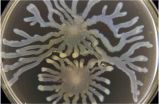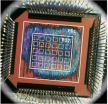(Press-News.org) ANN ARBOR, Mich. — People with bleeding brain aneurysms have the best chance of survival and full recovery if they receive aggressive emergency treatment from a specialized team at a hospital that treats a large number of patients like them every year, according to new guidelines just published by the American Stroke Association.
Diagnosing and immediately treating this kind of "bleeding stroke", and using advanced techniques to prevent re-bleeding and aneurysm recurrence, reduces the chance of immediate death and disability by 30 percent for patients with aneurysm-related subarachnoid hemorrhages (aSAH), according to the newly published guidelines.
What's more, this kind of evidence-based treatment means better long-term survival and quality of life for survivors, say the guideline's authors, who include University of Michigan neurosurgeon B. Gregory Thompson, M.D. The guideline is published online in the journal Stroke.
In a subarachnoid hemorrhage, blood collects on the surface of the brain after leaking from an aneurysm, or a weak spot in a brain blood vessel. About 5 percent of all strokes are caused by aSAH, which can occur at any time in any of the millions of Americans who have brain aneurysms.
Many people who suffer an aSAH have no idea they have an aneurysm. Their first sign is a severe headache – "the worst headache of their life" as many describe it -- that comes on suddenly and doesn't fade away for hours if at all. The condition is often misdiagnosed.
The guidelines emphasize the importance of getting such patients diagnosed quickly – and transporting them immediately to a hospital that treats more than 35 aSAH patients in a year, which typically have a multi-specialty team available to quickly assess and treat each patient.
"The take-home message for physicians and patients is that admission to specialized high volume centers is associated with lower rates of death and disability," says Thompson, who heads U-M's cerebrovascular team and is the John E. McGillicuddy Collegiate Professor of Neurosurgery at the U-M Medical School.
Last year, more than 100 subarachnoid hemorrhage patients were treated by U-M's team, as well as more than 200 brain aneurysm patients who had their condition treated before a hemorrhage could occur.
Because each aneurysm is different, the team of physicians must decide quickly what technique they will use to prevent aneurysm re-bleeding. For some patients, the aneurysms are treated by microsurgery to "clip" the aneurysm – and for others, the treatment choice is use of minimally invasive endovascular (through the blood vessel) techniques, which employ coils, stents and other implants inserted through a catheter and threaded into the brain through blood vessels in the neck.
At a few highly specialized centers, such as U-M, a "brain bypass" operation that transplants a section of blood vessel from the arm or leg into the brain can be done for patients with "unclippable" or ruptured fusiform aneurysms, an especially complex type to repair.
Patients with an aSAH need to be treated within hours of the start of their hemorrhage, though the urgency is not quite as time sensitive as the more common type of stroke caused by a clot that blocks blood flow into the brain. In about 50 percent of patients with subarachnoid hemorrhage the blood clot at the site of the arterial weakening between the brain and skull stops the arterial leak long enough for the patients to survive and be treated successfully. But if the bleeding begins again before the aneurysm can be secured, the risk of death is even higher, says Thompson.
"We want to treat these patients within the first 24 hours after their hemorrhage, to prevent re-bleeding and to give them the best chance for full recovery," he says. "Mortality increases to 80 percent after a second hemorrhage."
That's why it's important for patients to seek emergency care for their initial symptoms, whether by calling 911 or going to a local hospital. And, the guidelines note, initial diagnostic imaging with CT, CT angiography or MRI, or cerebrospinal fluid analysis, is needed to pinpoint the cause of symptoms. The guideline also calls for the immediate use of drugs to bring down blood pressure.
Thompson notes that the availability of medical helicopters staffed by trained teams, such as U-M's Survival Flight, helps speed patients to a highly experienced hospital.
Even after the initial operation, careful management of aSAH patients in Intensive Care Units and after discharge from the hospital is also crucial, say the guideline authors. U-M's Neurointensive Care Unit is an example of the kind of specialized inpatient care that can increase the odds of healthy survival, says Thompson. After the hospital stay is over, patients can benefit from the kind of testing and treatment offered through programs such as U-M's Stroke Rehabilitation Program.
INFORMATION:
The new guidelines were written by a team of clinicians with no major ties to industry, which helps ensure the independence of their recommendations. The full guideline is available for free at http://stroke.ahajournals.org/content/early/2012/05/03/STR.0b013e3182587839.
DOI: 10.1161/STR.0b013e3182587839
In addition to Thompson, the guideline authors are Sander Connolly, Jr, Alejandro A. Rabinstein, J. Ricardo Carhuapoma, Colin P. Derdeyn, Jacques Dion, Randall T. Higashida, Brian L. Hoh, Catherine J. Kirkness, Andrew M. Naidech, Christopher S. Ogilvy, Aman B. Patel and Paul Vespa.
Patients interested in learning more about subarachnoid hemorrhage, stroke and brain aneurysm care at U-M should call 1-800-211-8181 or visit http://www.uofmhealth.org/medical-services/stroke.
The University of Michigan Health System has earned a reputation as a leader in neurological, neurosurgical, spine and cranial base diagnosis, care, research and education -- offering the best care possible for thousands of patients a year. This commitment continues with an investment of $163 million to create the state's first Neuroscience Hospital and bring together imaging, surgical and inpatient care for adults with a broad range of brain, spine and nervous system conditions. State-of-the-art clinical care by trained subspecialists is backed up by advanced research into disease mechanisms, novel therapies and clinical care delivery.
END
The Debate Continues
The need for surgery can make anyone feel vulnerable. Most people find solace in the fact that they will be treated by surgeons with many years of training. Even so, the rate of medical mistakes that result in injury or death is shocking: a 1999 study by The Institute of Medicine reported that medical errors were responsible for almost 100,000 deaths and more than one million injuries every year in the United States.
Those rates have steadily increased in the past 13 years since that study was performed. In fact, The New England Journal of Medicine ...
Toronto, CANADA (May 17, 2012)— By focusing on the identification of common genetic variants, researchers have identified 57 single nucleotide polymorphisms (SNPs) that predict—with a high degree of certainty--the risk that siblings of children with Autism Spectrum Disorder (ASD) will also develop the condition. The findings were presented at the International Meeting for Autism Research.
ASD is among the most common form of severe developmental disability with prevalence rates up to 1 in 88 children. Boys are greater than four times more likely to be diagnosed with ...
Scientists at The University of Nottingham have opened the way for more accurate research into new ways to fight dangerous bacterial infections by proving a long-held theory about how bacteria communicate with each other.
Researchers in the University's School of Molecular Medical Sciences have shown for the first time that the effectiveness of the bacteria's communication method, a process called 'quorum sensing', directly depends on the density of the bacterial population. This work will help inform wider research into how to stop bacteria talking to each other with ...
A recent pit bull attack led to the tragic death of an East Texas boy and many questions about dog bite liability. The four-year-old had wandered away from home around sunset and was found dead late the next morning by a neighbor after an all-night search by family members and more than 100 volunteers and law enforcement officers.
The boy had apparently entered the neighbor's yard about a half mile from home, where several dogs were restrained. A Victoria County Sheriff's Deputy told reporters that one of the dogs, a pit bull or pit mix, had mauled the boy. Media attention ...
The Federal Motor Carrier Safety Administration (FMCSA) issued new regulations that ban commercial motor vehicle drivers from using handheld cell phones. The regulations became effective on January 1, 2012.
These regulations have forced many trucking companies to revise their communication policies with their drivers. Cell phones provide a quick and convenient method for companies and their dispatchers to remain in contact with their driver and shipments.
If a crash occurs when a driver is talking or texting on a cell phone there is a strong inference that the phone ...
VIDEO:
New research from Kennedy Krieger finds that a simple pull-to-sit task at six months of age may predict risk of an autism spectrum disorder. Researchers at Kennedy Krieger identified weak...
Click here for more information.
BALTIMORE, Md. – A new prospective study of six-month-old infants at high genetic risk for autism identified weak head and neck control as a red flag for autism spectrum disorder (ASD) and language and/or social developmental delays. Researchers at the ...
Lake Mead, on the Colorado River, is the largest reservoir in the United States, but users are consuming more water than flows down the river in an average year, which threatens the water supply for agriculture and households. To solve this imbalance scientists are proposing a Cap and Trade system of interstate water trading. The proposal, published in Journal of the American Water Resources Association (JAWRA), builds on the success of such an initiative in Australia.
The research was inspired by a first-year university assignment by Noelani (Olenka) Forde, who was studying ...
Most drivers are aware that a DUI conviction can lead to the installation of an ignition interlock device in their vehicle. An ignition interlock, of course, will not allow a vehicle to start unless the driver breathes into the device and passes a test for alcohol consumption; the driver may also be required to periodically provide a breath sample while the engine is in operation.
The consequences of a DUI arrest can be harsh if you are ultimately convicted, and an ignition interlock may be the least of your worries. But forget alcohol testing as a consequence: some ...
HOUSTON -- (May 17, 2012) -- Researchers have unveiled an "inexact" computer chip that challenges the industry's dogmatic 50-year pursuit of accuracy. The design improves power and resource efficiency by allowing for occasional errors. Prototypes unveiled this week at the ACM International Conference on Computing Frontiers in Cagliari, Italy, are at least 15 times more efficient than today's technology.
The research, which earned best-paper honors at the conference, was conducted by experts from Rice University in Houston, Singapore's Nanyang Technological University ...
Samuel Lee Sanders, 37, was arrested in early April on a laundry list of charges. Police in Washington County booked Sanders on suspicion of driving under the influence of intoxicants (DUII), reckless endangering, reckless driving, refusal of a breath test and driving with a suspended license.
Significantly, Sanders had two young children with him in the car at the time of his arrest. If he is unable to stage a successful Oregon drunk driving defense, this could mean substantially increased penalties.
Reckless Endangering Charge Tacked On For DUII With Children in ...

